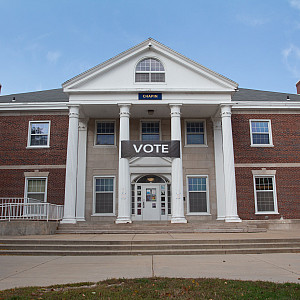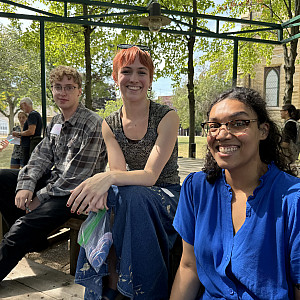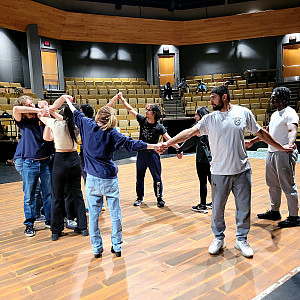Humans of Beloit: Shelbi Wilkin
Shelbi Wilkin arrived in the theater and dance department in the Fall of 2018, hot off a Master of Fine Arts program in costume design from the University of Oregon. Wilkin spends her days among colorful fabrics and drawers of buttons in the college’s Costume Shop in Neese Performing Arts Center, where she oversees the creation of costumes for dance and theatrical performances, and passes along her passion to students through courses in costume design, stage makeup, and fashion history.
Why costume design?
I’ve always been drawn to human beings, and why we wear what we wear, and costume design was the way to bridge both the cultural understanding of clothing, as well as my artistic desires to then present that onstage.
One of your titles at Beloit is Costume Shop Manager for the theater and dance department. What does that entail?
Any costume that goes onstage has to come through me. Whether we make it or buy it, I’m the person in charge of that. For theater productions, oftentimes we’re building costumes as well. For “In the Next Room” [a play by Sarah Ruhl, premiering in Neese Theater on Nov. 14 at 7:30 p.m.] specifically, there’s a lot of garments that are from the 1880s that had to be patterned, so either I pattern or I have a student employee pattern them. We go from the rendering to the pattern, make a muslin mockup, and then fit that on the actor. We try to make sure that everything’s tailored for an actor so they’re most comfortable onstage in what they’re wearing.
You’re also adjunct assistant professor of costume design. What courses are you teaching?
This term, I’m teaching an Advanced Costume Techniques class, where we’re delving into the understructure of clothing, specifically tailoring skills. My students are currently learning how to tailor jackets the way that you’ll see a high-end jacket, say, at Macy’s. They’re learning about the different canvas understructure pieces that force the shape of the lapel in front of the jacket to create that really clean, elegant look.
How did you end up at Beloit?
I got this job out of grad school. It was a wonderful job and an opportunity, so I chose to move from Oregon to here.
What’s the first play you ever worked on?
“The Sound of Music” in high school. I made all of the nuns’ habits.
How is Beloit’s theater and dance department unique?
What I think is an excellent quality of this theater department is that we allow students to experience different areas of theater. I can have a student working in the Costume Shop, and also being in a play. I think that’s a wonderful way to really expose them to what theater is, especially when you leave, because there’s going to be more opportunities for students that don’t specialize in one area specifically. The fact that we give them both the production and the performance side of theater really helps inform them about the industry itself. And it forces collaboration, in a very unique way.
The students [are] the most rewarding thing about working here. You’re never sure what your students’ skill set is when you take on a position… but [when] you have these students who live up to your expectations in such a lovely manner—in their ability to problem-solve in the Costume Shop—it’s wonderful. And their desire to design and produce beautiful images onstage, I think is really great; and the fact that they’re constantly challenging us to be better, I think is a really nice aspect of the students here at Beloit.
You worked with Qurat [ul Aain, an exchange student for the 2018-2019 school year from Istanbul Şehir University] on her sustainable fashion project last year. What did being a part of that undertaking teach you?
Qurat came to me with the desire to work on some kind of sewing project; that’s how she ended up in the Costume Shop. She was working in CELEB [Beloit’s Center for Entrepreneurship] with the entrepreneurship class, and wanted direction. She ended up realizing that she really had a desire to look into sustainable clothing practices.
Fortunately, costume shops are one of the models of sustainable fashion within our society. We don’t exist in the same world that fast fashion does because we have a large stock upstairs that we’re constantly rotating through and using in productions. We reuse; we alter; we buy from thrift stores. So [the Costume Shop] was a great place to start when she realized that this was a project that meant something to her.
It was great, because I could help her with sources, and then she could provide data to me that I wasn’t aware of, as we really delved into the project. Her experiences living in a country [Aain grew up in Islamabad, Pakistan] that is affected so tangibly by the fast fashion industry was a really nice eye-opener in general. Like, I understand the concepts, but to talk to someone who has experienced the aftermath of our waste from our country is really fascinating.
Is there any one play you’re dying to work on?
That’s always a hard question: there are plenty of plays that I’d love to work on. I love opera, because you can be extravagant in the design in a way that you can’t always with a stage play, so any opera is on my list. I really love the rococo era, so I always enjoy putting that onstage.
I’ve always had a desire, ever since I was in high school, to design for “Chicago.” It’s not so much the costumes themselves, as it’s just been a desire since I was a kid, when I first found that I loved musicals, that would be fun to fulfill someday.
Finally, on the theater department’s website, you write that you like to one-up other faculty member’s cats with stories about your own cats. I thought I’d give you an opportunity to do that now.
We all realized that we needed a short blip in our bios about our cats. My cat Loki can sit, shake, and he sits pretty like a gopher on demand. For treats, of course.



